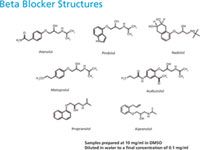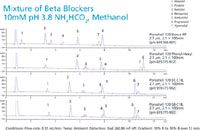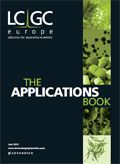Fast Screening Methods for Beta Blockers by HPLC with Agilent Poroshell 120 Columns
Agilent Application Note
Beta blockers can be abused in sports involving little physical activity, such as archery, to reduce cardiac contraction, heart rate and coronary blood flow. They have, therefore, been included in the list of forbidden substances by the International Olympic Committee. Selectivity is the most powerful tool to optimize separations in HPLC. This parameter is changed by using different bonded phases, including C18, C8, polar-embedded and phenyl-bonded phases, or by changing the mobile phase. In this work, Agilent Poroshell 120 columns and the Agilent 1200 Infinity Series LC Multi-Method Solution were used to quickly evaluate method development choices for the analysis of beta blockers. The short column length and high efficiency provided short analysis times and rapid equilibration leading to fast investigations of selectivity.
Experimental
An Agilent 1200 Infinity Series LC Multi-Method Solution was used. This system consisted of:
- 1260 Infinity Binary pump (G1312B)
- 1290 Infinity Thermostatted Column Compartment (G1316C)
- 1260 Infinity High Performance Autosampler (G1367E)
- 1290 Infinity Diode-Array Detector (G4212A), equipped with 10 mm MaxLight cartridge flow cell
- G6140 Single Quadrupole Mass Spectrometer.
The Agilent 1200 Infinity Series LC Multi-Method Solution is a highly flexible system that can be used for up to 4 (100 mm) columns. In this work 4 Agilent Poroshell 120 columns were used.
The TCC was fitted with a 6 position/14 port column selection valve. This is a new Quick Change Valve mounted on a slide-out rail to make plumbing and maintenance more convenient. Port 1 was connected to a StableBond C18 column, and port 2 was connected to EC-C18. Port 3 was connected to Bonus-RP, port 4 to PhenylHexyl and port 6 to a bypass connecting capillary.
The solvent passing into each column was heated using 1 of 4 individual low-dispersion heat exchangers. An additional external 12-solvent selection valve was connected to channel A1 on the 1260 Infinity Binary pump. Together with the internal solvent selection valve of the 1260 Infinity Binary pump, up to 15 solvents could be screened using this system.
Column Choice to Enhance Selectivity
A polar-embedded group inserted into the hydrophobic C14 alkyl chain allows the Bonus-RP phase on totally porous Poroshell 120 to minimize interaction of polar samples with silanols, providing symmetrical peaks for a wide variety of applications. This phase is especially useful at neutral pH where amines can interact strongly with ionized silanols. The polar-embedded group also helps to wet the hydrophobic chains, and prevents phase collapse in highly aqueous mobile phases.

Figure 1: Structures of some beta blockers.
Poroshell 120 Bonus-RP can be used for many of the same separations as a C18 column while avoiding some of the disadvantages of C18, such as poor wettability in high aqueous mobile phases. In addition, it is much more retentive for those molecules that can interact by hydrophobic interactions and also by H-bonding with the amide group. Compared to alkyl only phases, Bonus-RP has enhanced retention and selectivity for phenols, organic acids and other polar solutes due to strong H-bonding between polar group (H-bond acceptor) and Hbond donors, like phenols and acids. Bonus-RP gives retention slightly less than a C18 and allows for easy column comparison without the need to change mobile phase conditions. The Bonus-RP phase gives different selectivity than C18 for polar compounds. It is also compatible with 100% water.
The Phenyl-Hexyl phase has unique reversed-phase selectivity, especially for polar aromatics and heterocyclic compounds, derived from analyte interaction with the aromatic ring of the bonded phase and its delocalized electrons. Poroshell 120 Phenyl-Hexyl can be orthogonal to both C18 and Bonus-RP phases. More retention and selectivity will often be observed for solutes with aromatic electronwithdrawing groups such as fluorine or nitro groups.
Poroshell 120 Phenyl-Hexyl can also provide optimum separations of moderately polar compounds where typical alkyl phases (C18 and C8) do not provide adequate resolution. Acetonitrile tends to decrease the π–π interactions between aromatic and polarizable analytes and the phenyl-hexyl stationary phases, but methanol enhances those same interactions, giving both increased retention and changes in selectivity. This does not mean that acetonitrile should not be used with a phenyl-bonded phase or that it might not provide an acceptable separation, but methanol is more likely to deliver the additional selectivity that is desired from a phenyl phase.

Figure 2: Separation of beta blockers using Agilent Poroshell 120 columns.
Results and Discussion
The separation of all 7 compounds was accomplished on all columns surveyed (Figure 2). The Poroshell 120 EC-C18 column showed very close elution of acebutanol and propranolol and a double peak with the same molecular ion for naldolol. The double peak for naldolol was attributed to a diastereomer. This was not found with the Poroshell 120 Bonus-RP column, as it tended to minimize secondary interactions. The Poroshell 120 Bonus-RP column also reversed peaks 6 and 7 (propranolol and alprenolol), compared to the C18 columns. The Poroshell 120 Phenyl-Hexyl column shared this 6, 7 peak reversal and additionally reversed peaks 4 and 5 (metoprolol and acebutolol). The separation was similar to that shown by the other C18 columns, but was not as retentive.
Conclusions
This work shows how phases with different selectivity can be used to optimize a separation. While the Poroshell 120 EC-C18 and SBC18 columns provide adequate separation, using an alternative selectivity column such as Poroshell 120 Bonus-RP yields even better results, and can be used for several thousand samples. Automatic setup of methods and sequences for the Poroshell 120 columns was straightforward using the Agilent 1200 Infinity Series LC Multi-Method Solution.
Agilent Technologies Inc.
2850 Centerville Road, Wilmington, Delaware 19808, USA
tel. +1 (877) 424-4536

Separating Impurities from Oligonucleotides Using Supercritical Fluid Chromatography
February 21st 2025Supercritical fluid chromatography (SFC) has been optimized for the analysis of 5-, 10-, 15-, and 18-mer oligonucleotides (ONs) and evaluated for its effectiveness in separating impurities from ONs.

.png&w=3840&q=75)

.png&w=3840&q=75)



.png&w=3840&q=75)



.png&w=3840&q=75)

















